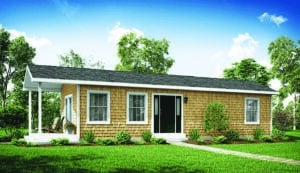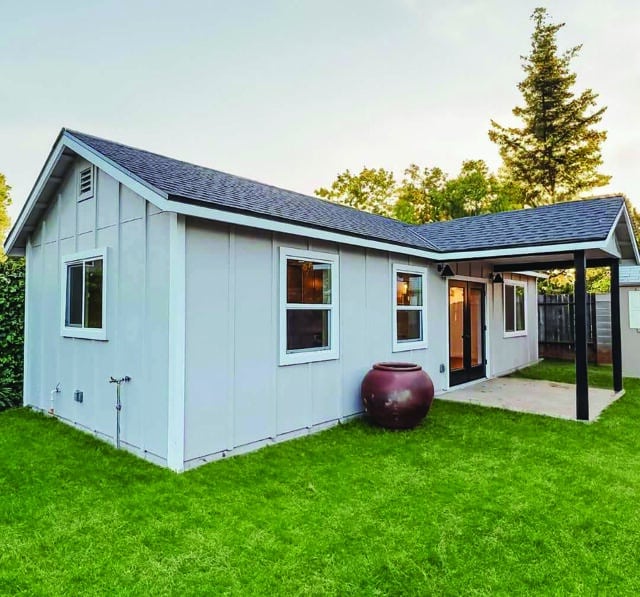
A computer rendering of Hyannis homebuilder CapeBuilt’s “Covell” design for an accessory dwelling unit it created in 2022 for residents of Cape Cod communities liberalizing their ADU bylaws. Image courtesy of CapeBuilt
Massachusetts can thank New Hampshire and other states if accessory dwelling units, also known as “in-law units,” ever become popular housing options across the commonwealth.
Tucked in Gov. Maura Healey’s $4.1 billion housing bill, designed to boost new home construction across the state, is a provision that would make it dramatically easier to add the apartments, also called ADUs, as additions to single-family homes and stand-alone units on the same lot over the objections of NIMBY-minded residents and some local zoning boards.
The fate of the proposal is not clear, as proponents and opponents battle behind closed doors on Beacon Hill over a number of thorny issues tied to Healey’s overall housing bill.
But one thing is clear: If the ADU provision is approved as written and prompts construction of possibly thousands of new rentable housing units, then the commonwealth will have learned from past mistakes by other states that initially tried, and largely failed, to spur widespread construction of new ADUs.
2017 Law a Disappointment
When Granite State legislators first passed a law allowing the construction of ADUs in 2017, some studies predicted it could lead to construction of tens of thousands of new units in New Hampshire.
Instead “maybe 1,000” ADUs have been built since 2017, said Ben Frost, deputy executive director and chief legal officer at the New Hampshire Housing Finance Authority. The state is around 31,000 homes short of what it needs to satisfy demand today, according to new estimates from housing advocacy group Up for Growth.
“It’s a lot less than what we should be building,” he said.
The chief culprit, Frost and others say: the 2017 law allowed municipalities significant leeway to control ADUs.
“There are so many things towns are requiring that it’s become de facto blocking of ADUs,” state Rep. Ellen Read, a Democrat from the Portsmouth suburb of Newmarket said. “There are many unnecessary restrictions.”
Read sponsored a bill this spring that sought to declare homeowners can build ADUs in single-family neighborhoods by right and restricts local authorities from slapping too many parking, size, owner-occupancy and other restrictions on ADU projects. The bill passed the New Hampshire House of Representatives with sizable bipartisan support, but died in the state Senate last month in the face of criticism it did too much to erode towns’ control over land use.
Jessica Stevenson, a real estate broker who runs a franchise of custom ADU construction company Anchor Tiny Homes with her husband Mark in southeastern New Hampshire, said there’s pent-up demand for the units in her area. Anchor’s models cost homeowners between $90,000 for a studio-like unit and $240,000 for a two-bedroom, she said.
“It can be frustrating. Every town does things differently. They put up their own rules and regulations. We help our clients navigate the process,” Stevenson said.
NH Seen as Cautionary Tale
Emily Hamilton, a housing economist at George Mason University, studied ADU ordinances in dozens of communities in New Hampshire and found numerous local restrictions, from mandatory parking spaces to owner-occupancy requirements, all of which led to disappointingly few ADUs getting built.
She described New Hampshire’s existing ADU law as “quite weak.”
The Granite State’s experience is hardly unique.
A Harvard Joint Center for Housing Studies paper last fall echoed Hamilton’s findings, and described problems faced by authorities in Oregon and others states when they also tried to boost construction of ADUs.
California had to overcome initial local opposition to ADU projects before passing a statewide “by right” bill that’s led to a spike in new ADU construction, from 1,300 units in 2016 to 25,000 units in 2022, the Harvard researchers wrote.
“The old status quo in New Hampshire and elsewhere led to little,” said Jesse Kanson-Benanav, executive director of Abundant Housing Massachusetts, a non-profit housing advocacy group.
Convinced Massachusetts needed to avoid the same mistakes of others, Kanson-Benanav said his organization distributed copies of the Harvard study to leaders on Beacon Hill as they crafted new housing legislation.
“There were certainly things to learn from our neighbors to the north,” said Kanson-Benanav. “We needed to be careful about poison pills that could be inserted into a bill here.”

An accessory dwelling unit design produced by Anchored Tiny Homes, a California-based ADU construction company that’s just launched a franchise in Southeastern New Hampshire. Photo courtesy of Anchored Tiny Homes
Healey Admin Hopes for 10K ADUs
The State House’s ADU backers listened to the advice.
The Healey administration’s bill contains many of the same concepts found in Read’s New Hampshire bill and in recent ADU laws passed by other states that attempt to rein in municipalities’ ability to create de facto bans on the units.
Among other things, Healey’s housing bill would prohibit towns from putting owner-occupancy requirements on ADU projects. Such owner-occupancy requirements make it almost impossible for homeowners to line up financing for ADU projects, supporters say.
The bill filed would also allow construction of ADUs up to a maximum 900 feet, limits parking requirements and would permit both attached and detached units.
Critically, the bill declares homeowners should be allowed to build ADUs “by right” next to their single-family homes, meaning they would not have to go before a zoning or planning board for a hearing to build, instead only having their plans vetted by the municipal building inspector.
Under Healey’s plan, local authorities would still retain the right to enforce setback, open space and other similar requirements.
Housing Secretary Ed Augustus said ADUs are part of the solution – although not the entire solution – to the state’s housing shortage. And they don’t cost taxpayers a dime since they’re built by private homeowners.
“It’s one of the few policies we’ve seen work,” Augustus said. “They unlock demand that’s already out there.”
He estimated the Healey provision, if passed, could lead to construction of 8,000 to 10,000 new units within about five years, as much as 10 percent of the state’s current near-term housing shortfall according to some estimates.
Opponents Want More Say for Towns
But opponents of the ADU provision say it undermines local zoning authority and, if passed, could lead to communities being overrun with new apartments.
“We are not anti-ADU,” said Adam Chapdelaine, executive director and CEO of the Massachusetts Municipal Association. “We think ADUs are a very valuable tool for addressing the housing shortage.”
But the Healey proposal goes too far, preempting local authority with “overarching” limits imposed on local governments, he said.
“We have to make sure local officials have some say,” Chapdelaine said.
The 2021 Housing Choice law, passed during the previous Baker administration, made it easier to build ADUs, largely by lowering municipal boards’ voting thresholds for approving zoning changes, from a two-thirds majority to a simple majority, Chapdelaine said.
As a result, a number of communities have since approved new ADUs, such as Arlington, Lexington, Newton and Salem, he said.
Will ADUs Be Over-Built?
But Augustus and Kanson-Benanav said many of the criticisms aimed at the ADU provision are not valid, including the idea that towns could get overrun by ADUs if the Healey measure is passed.
“It’s simply not true,” Augustus said of potential overbuilding of ADUs. “It just hasn’t been borne out in other states.”
Data from California, flagged by the Harvard housing researchers as an example of how successful ADUs might be, appears to bear Augustus’ contention out. Although the spike in ADU permitting was concentrated in Los Angeles County, according to the California Department of Housing and Community Development, the nearly 52,862 ADU permits issued there between 2017 and 2023 were spread across an urban area with roughly 1.64 million single-family homes, according to Census Bureau data – only about 3 in every 100 houses.
Kanson-Benanav said ADUs are an important part of the solution to easing the overall housing crisis in Massachusetts.
“They’re just common sense,” he said. “They’re easy and less expensive to build than other forms of housing. And they’re great value-adds for homeowners.”




